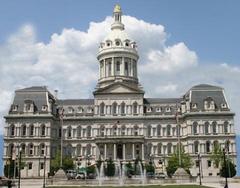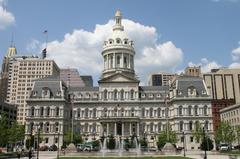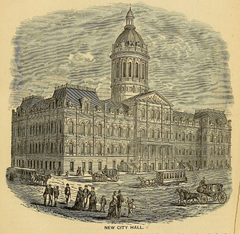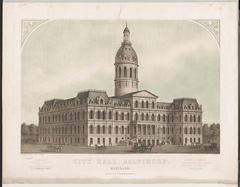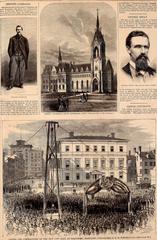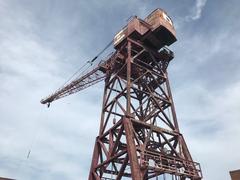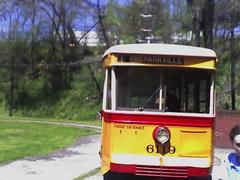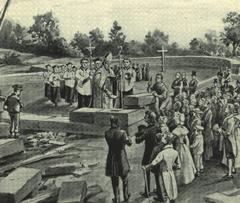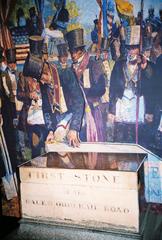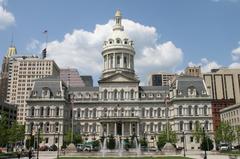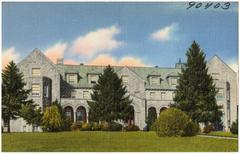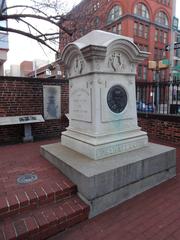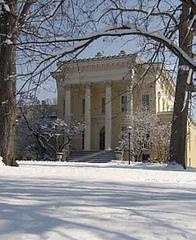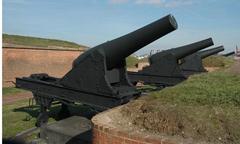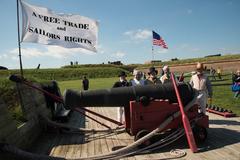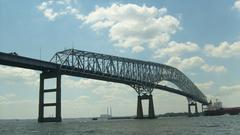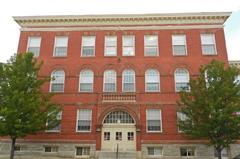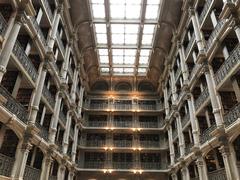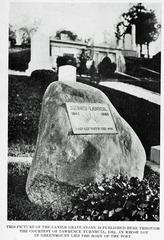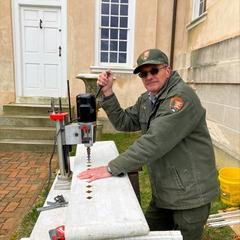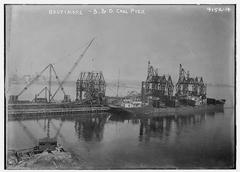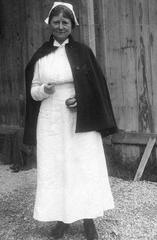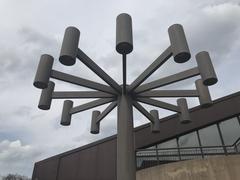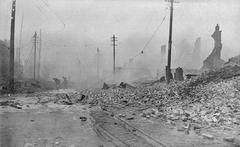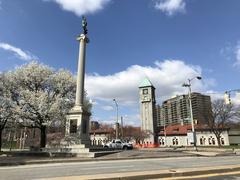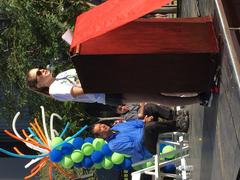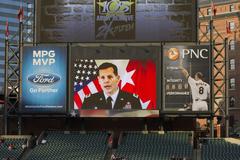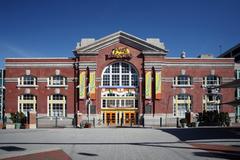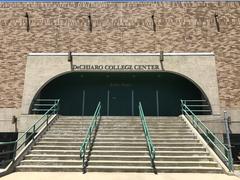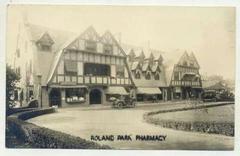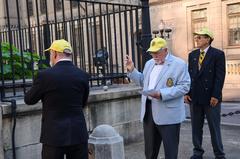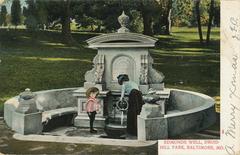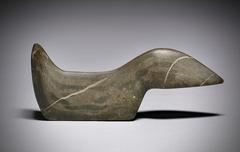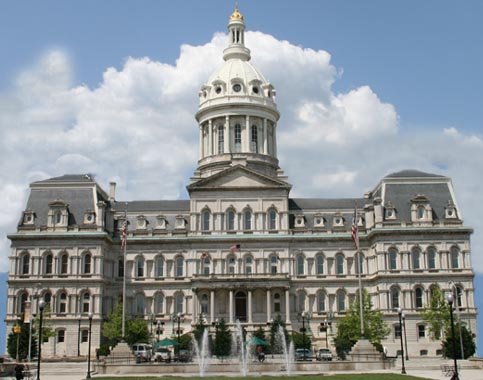
Baltimore City Hall Visiting Hours, Tickets, and Historical Sites Guide
Date: 15/06/2025
Introduction
Baltimore City Hall stands as a defining symbol of the city’s civic pride, architectural splendor, and historical significance. Since its dedication in 1875, it has served not only as the seat of Baltimore’s municipal government, but also as a vibrant hub for public events, civic engagement, and architectural appreciation. Designed by George Aloysius Frederick, this Second Empire masterpiece features a striking mansard roof, grand dome, and intricate marble façade, making it a must-visit landmark for history enthusiasts, architecture aficionados, and casual travelers alike.
This detailed guide covers everything you need to know for your visit—including City Hall’s history, architectural highlights, current visiting hours, accessibility, travel tips, and nearby attractions—so you can make the most of your experience in Baltimore’s civic heart.
For official visitor information, tour scheduling, and historical context, please consult the following resources: Baltimore City Hall Tour (baltimore.org), CHAP Landmark List, and Baltimore City Government.
Table of Contents
- Introduction
- History and Origins
- Architectural Significance
- Civic Role and Cultural Importance
- Preservation and Restoration
- Visiting Hours, Tickets, and Tours
- Accessibility and Visitor Amenities
- Travel and Safety Tips
- Nearby Attractions and Suggested Itineraries
- Frequently Asked Questions (FAQ)
- Conclusion and Recommendations
- Sources
History and Origins
Baltimore’s city government operated from various locations throughout the 19th century, reflecting the city’s rapid growth and evolving civic needs. Prior to City Hall’s construction, officials met in buildings such as the Maryland Insurance Company, Dancing Assembly Rooms, and Peale’s Baltimore Museum and Gallery of Fine Arts (Wikipedia). The post-Civil War era called for a permanent and grand seat of government, resulting in the commissioning of a dedicated municipal building.
Construction began in 1867, with the cornerstone laid during a notable public ceremony. Frederick’s design was selected for its embodiment of the Second Empire style, and the building opened in 1875 after eight years of construction and a significant investment of $2.27 million (SAH Archipedia). The project signaled Baltimore’s ambition and stature as a leading American city.
Architectural Significance
Baltimore City Hall is renowned as one of the earliest and best-preserved examples of Second Empire architecture in the United States (Baltimore City Hall Tour). Key features include:
- Mansard Roofs and Dormers: Distinctive rooflines that define the building’s silhouette.
- Grand Central Dome: Rising approximately 227 feet above street level, the dome is a city landmark. It features a double-shell design for both structural stability and aesthetic grandeur.
- Maryland Marble Façade: Locally quarried marble is intricately carved with classical details, including pilasters, balustrades, and elaborate window surrounds.
- Baroque-Inspired Rotunda: The interior centerpiece, with a dramatic oculus, Corinthian columns, marble floors, and decorative plasterwork.
- Cast Iron Structural Elements: Innovative for the time, cast iron was used for grand staircases and columns, painted to mimic marble and ensure fire resistance.
The building’s symmetrical design, lavish interiors, and attention to detail reflect Baltimore’s aspirations and Frederick’s architectural prowess (CHAP Landmark Report).
Civic Role and Cultural Importance
Since opening its doors, City Hall has continuously housed the Mayor’s office, City Council chambers, and other municipal departments (Historic American Buildings Survey, 1933). It remains a living institution where governance and public life intersect—hosting mayoral inaugurations, council meetings, civic celebrations, and public forums.
The rotunda is frequently used for ceremonial occasions, and the building’s steps have served as a stage for rallies and community gatherings (HMDB.org). Its enduring role underscores City Hall’s status as both a government center and a civic symbol.
Preservation and Restoration
By the mid-20th century, City Hall required significant repairs due to structural wear and outdated systems. Rather than replace the building, Baltimore invested in comprehensive restoration beginning in 1974, focusing on dome repair, structural modernization, and preservation of historic interiors (SAH Archipedia). Further work in 2009 addressed façade deterioration.
Today, City Hall is a designated Baltimore City Landmark and listed on the National Register of Historic Places (CHAP Landmark List), representing the city’s commitment to architectural heritage.
Visiting Hours, Tickets, and Tours
- General Hours: Open to the public Monday through Friday, 8:30 AM to 4:30 PM. Closed on weekends and public holidays. Always verify hours before your visit on the official website.
- Admission: Free. No ticket required for general entry. Security screening is mandatory for all visitors.
- Guided Tours: Offered periodically, especially during Doors Open Baltimore and similar events (Doors Open Baltimore). Advance registration is recommended as availability is limited.
- Self-Guided Tours: Explore at your own pace; the GPSmyCity app offers downloadable walking tours that include City Hall and nearby sites.
Accessibility and Visitor Amenities
- Wheelchair Access: Entrances are ramped, and elevators serve all public floors.
- Restrooms: Accessible facilities are available on the main floor.
- Assistance: Staff at the information desk can provide support for visitors with disabilities; service animals are welcome.
- Photography: Permitted in most public areas. Please observe any restrictions posted or announced by staff.
- Security: All visitors undergo security screening. Photo ID may be required.
Travel and Safety Tips
- Getting There: Located at 100 N. Holliday Street, City Hall is accessible via the Charm City Circulator, Light Rail, Metro Subway, and multiple MTA bus routes. Public transit is recommended due to limited and expensive downtown parking.
- Parking: Metered street parking and nearby garages are available, but may be costly and limited during peak times.
- Safety: Downtown Baltimore is generally safe during the day, with a strong police presence. Exercise common-sense precautions, especially after dark or when walking in less populated areas.
- Nearby Dining: Numerous cafes and restaurants are within walking distance, especially along Fayette and Lexington Streets.
Nearby Attractions and Suggested Itineraries
Baltimore City Hall is ideally positioned for exploring other historical and cultural sites:
- The Walters Art Museum: Diverse art collections spanning millennia.
- Baltimore Basilica: America’s first Roman Catholic cathedral.
- Inner Harbor: Home to the National Aquarium, historic ships, and waterfront attractions.
- Peale Museum: The city’s first public museum, located nearby.
- Edgar Allan Poe House & Museum: Explore the life of the famed writer.
Consider using self-guided walking tours from the Baltimore Heritage Area Association or GPSmyCity for a comprehensive experience.
Frequently Asked Questions (FAQ)
Q: What are Baltimore City Hall’s visiting hours?
A: Monday–Friday, 8:30 AM to 4:30 PM. Closed on weekends and public holidays.
Q: Is there an admission fee?
A: No, entry is free.
Q: Are guided tours available?
A: Yes, but they require advance reservation and are subject to availability.
Q: Is City Hall wheelchair accessible?
A: Yes, with ramps, elevators, and accessible restrooms.
Q: Can I take photographs inside City Hall?
A: Yes, in most public areas. Some restrictions may apply during official events.
Q: What should I bring for entry?
A: A government-issued photo ID and minimal personal belongings to expedite security screening.
Conclusion and Recommendations
Baltimore City Hall is an architectural marvel and a living center of civic life, offering visitors a unique window into the city’s past, present, and future. Whether you are admiring its Second Empire design, attending a council meeting, or using it as a launch point for exploring nearby landmarks, City Hall is an essential stop in any Baltimore itinerary.
To maximize your visit:
- Check the official website for up-to-date hours and tour availability.
- Use public transit to simplify your journey.
- Download the Audiala app for guided tours and insider tips.
- Share your experiences and photos to inspire others to discover Baltimore’s heritage.
Sources
- Baltimore City Hall Tour (baltimore.org)
- SAH Archipedia: Baltimore City Hall (2025)
- Commission for Historical and Architectural Preservation (CHAP) Landmark Report (2025)
- Wikipedia: Baltimore City Hall (2025)
- Baltimore City Government – Commission for Historical and Architectural Preservation (2025)
- Baltimore Visitor Guide (2025)
- Historic American Buildings Survey (1933)
- HMDB.org: Baltimore City Hall Historical Marker (2025)
- Baltimore Magazine: Baltimore’s Historic City Landmarks (2025)
- Doors Open Baltimore (2025)
- GPSmyCity: Baltimore City Hall Walking Tours (2025)
- Baltimore Heritage Area Association (2025)
For visuals, virtual tours, and additional planning resources, visit the official Baltimore City Government website and affiliated heritage organizations.
